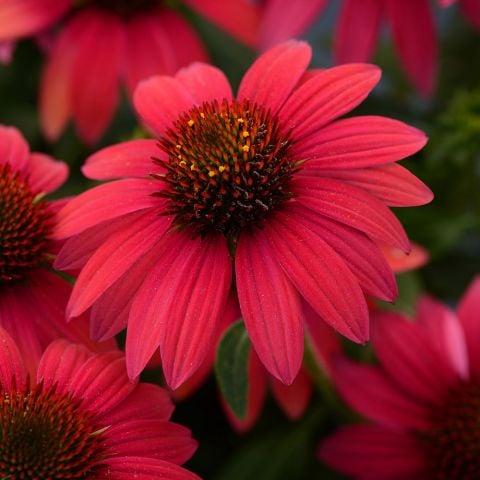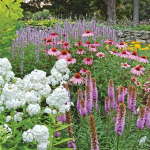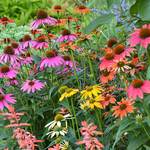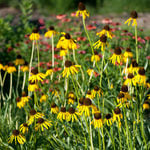Coneflower (Echinacea) Care
Latin Name Pronunciation: ek-in-ay'see-uh
Native to eastern and central North America, these sturdy perennials bloom from early summer until frost. Butterflies revel in the flowers and the seeds provide nourishment for birds. Easy to grow and trouble-free, Echinacea (Coneflower) is at home in the wild garden as well as in the more refined perennial border, and make ideal cut flowers. In recent years, plant breeders have released the beauty hidden within these rugged wildflowers, creating double-flowered Coneflowers, fragrant Coneflowers, and Coneflowers in an astounding palette of new and vivid colors. We've been growing and evaluating Coneflowers in our trial gardens for years and are confident that those we've chosen to offer will invigorate any sunny border, meadow, or cottage garden.
Please note: So plants may properly establish before winter, we recommend early fall planting of Echinacea in colder zones (Zones 5 and lower).
Growing Echinacea
Light/Watering: Flowering is at its best in full sun, although plants will tolerate light shade. Deep taproots make these plants quite drought-tolerant once established.
Fertilizer/Soil and pH: Echinacea purpurea is adaptable to most soil types but prefers a sandy, well-drained loam and a pH from 6.0 to 7.0. Applying a couple inches of organic matter, such as compost or well-rotted manure, around the plants in early spring will take care of nutritional needs; no further fertilizing will be necessary.
Pests/Diseases: Echinacea is rarely troubled by pests or diseases, none serious enough to warrant control measures. Plants do attract beneficial insects, especially firefly-like soldier beetles, which feed on aphids and caterpillars.
Companion Plants: Shorter perennials camouflage occasional legginess; compact varieties of Catmint (Nepeta) are ideal companions as are perennial Geraniums, dwarf Goldenrods (Solidago), and Salvia. Taller companion plants include Perovskia, Phlox, Sedum, Veronica, and Monarda.
Reflowering: Echinacea has a long bloom season even without deadheading, but that practice will result in more blooms. Plants can be cut back by half in early summer, resulting in a later bloom time but more compact form. Leave some seed heads to provide food for goldfinches -- there are few sights more delightful than watching the small, golden birds wave about as they pick out the seeds.
Dividing/Transplanting: Plants rarely need dividing, and transplanting older plants can be tricky due to the taproot. It can be done, however, as long as you dig deeply and keep a good amount of soil around the roots.
Calendar of Care
Early Spring: Divide or transplant now, watering well afterward.
Late Spring: Provide supplementary water only if the season is extremely dry or if the Coneflowers are newly planted.
Summer: Deadhead if desired, but leave some seeds for the goldfinches. Watch for beneficial soldier beetles in August and do not harm them. Plants may be cut back by half in June; this will result in later-flowering, more compact growth.
Fall: A light mulch in colder regions is beneficial. Plants may be left standing through winter as the seeds heads provide sustenance to hungry birds and collect snow in pretty little puffs
Frequently Asked Questions
Coneflower height?
Depending on the variety, their height can range from 6" to 40".
Are Coneflowers deer resistent?
Deer don't generally favor Coneflowers but will eat them if they're hungry enough.
Do Coneflowers attract pollinators?
Yes. Many species of butterflies and bees relish the flowers and goldfinches favor the seedheads.






